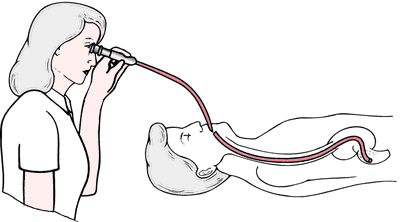Turinys
Virškinimo endoskopijos apibrėžimas
Taip pat vadinama eso-gastro-duodenal fibroscopy, “upper” digestive endoscopy is an examination that allows you to visualize the inside of the upper digestive tract (stemplė, skrandis, dvylikapirštės žarnos) thanks to the introduction of a flexible tube called fibroskopas ou endoskopas. We can also talk about gastroskopas (and gastroscopy).
Endoscopy can also involve the “low” digestive tract, that is to say the dvitaškis ir tiesiojoje žarnoje (we are talking about kolonoskopija and the probe is introduced through the anus).
The fiberscope (or video endoscope) is a medical instrument made up of optical fibers (or optoelectronic components), a light source and a camera. The fiberscope also includes an operating channel, through which the doctor can take samples and small therapeutic gestures such as cauterization. At its end, the fiberscope can describe a rotation of 360 degrees.
Why perform a digestive endoscopy?
Gastrointestinal endoscopy is performed to diagnose a digestive disease, follow its evolution or treat it. The doctor will, for example, have recourse to this examination in the following cases:
- į cas iš digestive bleeding, digestive pain or disturbances išlikti
- ieškoti inflammatory lesions (esophagitis, gastritis, etc.)
- ieškoti a skrandžio ar dvylikapirštės žarnos opa
- to screen for cancerous lesions (the doctor can then perform a biopsy: taking a piece of tissue for analysis)
- or to stretch or widen a narrowed area of the esophagus (stenozė).
Egzaminas
The examination is carried out while the patient is the patient is placed under general anesthesia or under local anesthesia. In this case, it is a question of spraying a local anesthetic into the throat, so as to avoid any unpleasant sensations linked to the passage of the fiberscope.
The patient is lying on his left side and holds a cannula in his mouth which guides the fiberscope into the esophagus. The doctor puts the fiberscope in the patient’s mouth and asks him to swallow if he is awake. The device does not interfere with breathing.
During the examination, air is blown in to smooth out the walls. The entire surface of the esophagus, stomach and duodenum then becomes visible.
If he deems it necessary, the doctor can carry out Pavyzdžiai.
What results can we expect from a digestive endoscopy?
Gastrointestinal endoscopy helps the doctor make a diagnosis by having visual access to the interior of the digestive tract.
If he takes tissue fragments, he will have to analyze them and make a diagnosis based on the results. Other examinations may be prescribed in the event of an anomaly.
Skaitykite taip pat: All about ulcers |










